“She becomes an Inaccessible Ghost”
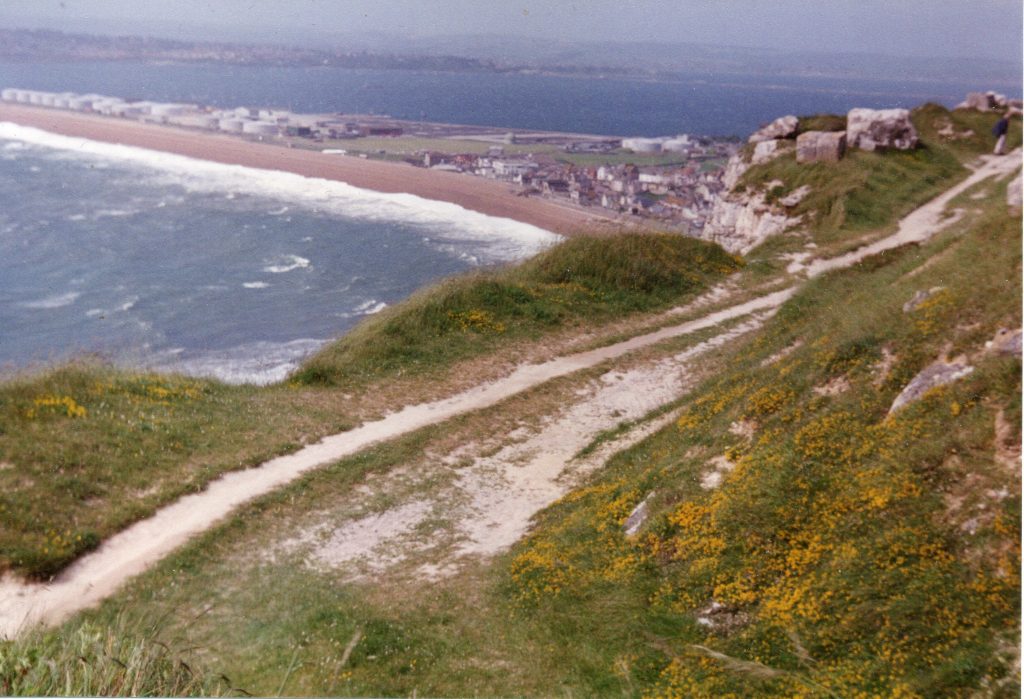
Chesil Beach from above Fortuneswell 3rd June 1994 – the oil refinery still in place
November 14th 1984: Wired by umbrella sun’s rays, showering rain breaks through the stale bread of sleep to brighten the tilted memory. Looking down, it finds the passing road solid, the air whole:
Anvils of interlocked cloud cast shadows on the metallic reach of the sea, a shine that rises beyond the ranked cylinders of oil storage tanks and the implicit menace of a naval base – blazing through the gaps, burning them out.
Through the flashes of bright and overcast, a sign passes: “Welcome to the Isle and Royal Manor of the Slingers.”[ii]
Jocelyn went from the house, but as the white road passed under his feet he felt in no mood to get back to his lodgings in the town on the mainland. He lingered about upon the rugged ground for a long while, thinking of the extraordinary reproduction of theoriginal girl in this new form he had seen, and of himself as of a foolish dreamer in being so suddenly fascinated by the renewed image in a personality not one-third his own age.[iii]
August 6th 2020: The most recent day of return did not look promising, but by Wyke Regis, rain had turned to drizzle and passing the Ferry Bridge Inn on the causeway, it ceased altogether. The vast pebble bank of Chesil Beach[iv] to the right, colonised here and there by the pale green flowerings of sea kale and plants that looked too exotic to enjoy the grey or cold or rain, lead us on . . .
By now, perhaps because of the 2012 Olympics, the oil refinery tanks and the warships are all gone and on our way back – the weather now turned to full-blast heatwave – posh sailing twits[v] populate the new Lidl supermarket . . . sparking an argument about facemasks they look too arrogant to even consider. To be honest I have doubts myself. Another piece of muddled tokenism – one to stall human relationships permanently or until further notice: words muffled; no expressions visible. A projection of both fear and absurdity. Plus: how many Tory MPs and friends have recently invested in facemask production, I wonder? . . . The melancholy ruins / Of cancelled cycles . . .[vi]
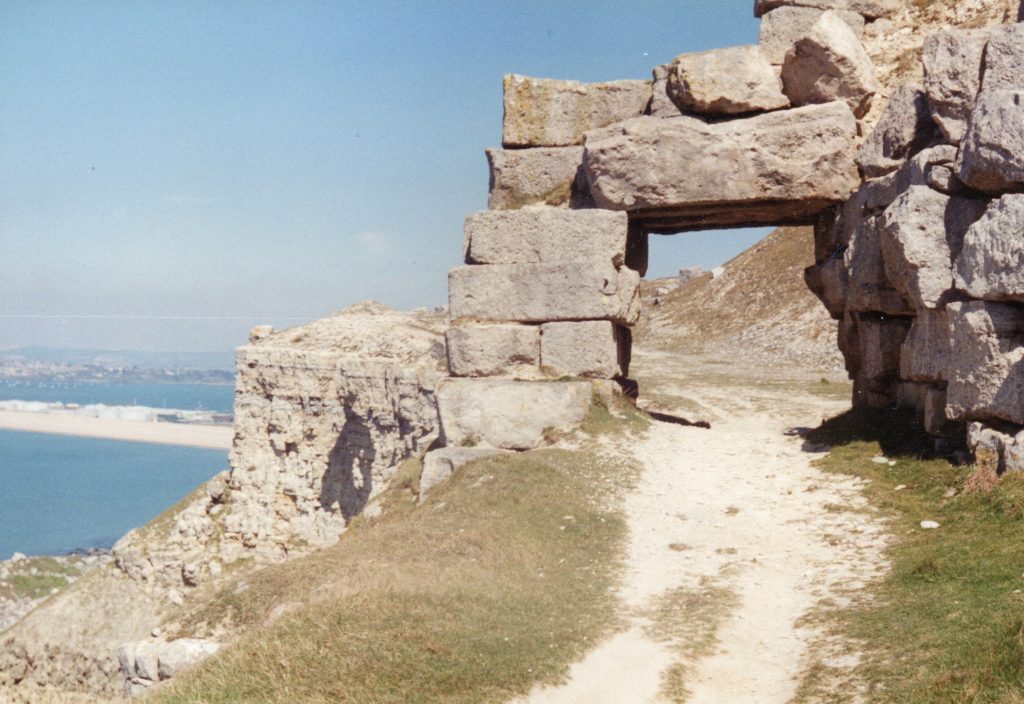
Old track bed Tout Quarry[vii] cliff edge, 3rd June 1994
November 14th 1984: After the causeway of pebbles reaches Fortuneswell, the busy road zigzags steeply, climbing the headland. Exits to quarries precede the plateau of bleak council houses, prison revetments and fortifications. Only the border exit from Derry[viii] during the worst years of the Troubles would match the atmosphere with precision[ix]. If the object were to recreate Northern Ireland in safety, on an overcast day here would be the place – so long as the lens remained tilted down, for the epic distance on this towering showery day, could hardly be more different – while in summer (under a hard sun with the sea-light reflecting), the isle becomes Mediterranean, with churchyards of leaning crosses and the white scars of quarries to hurt the eyes[x].
Where the angled fields at the Bill, wedge into the churning tides of Portland Race, the distinctive meets the primordial.
Looking back from the lighthouse banded in red and white, glaring against leaden Channel seas, the eastern coast is cut by right-angled shelves and riddled with ancient cranes, while westward, high before the distant sweep of Chesil Beach, another suspicious establishment fences itself into grassy hilltop isolation[xi].
He remembered a long conversation with Lucy about landscape, light and personality, in which they tried to conflate the obscure and the obvious. As with people, so places deepen the more you realise their history. Although they can be washed clean, born again every spring or under every shining spell of weather, their certain, distinctive history, paradoxically increases their timelessness.[xii]
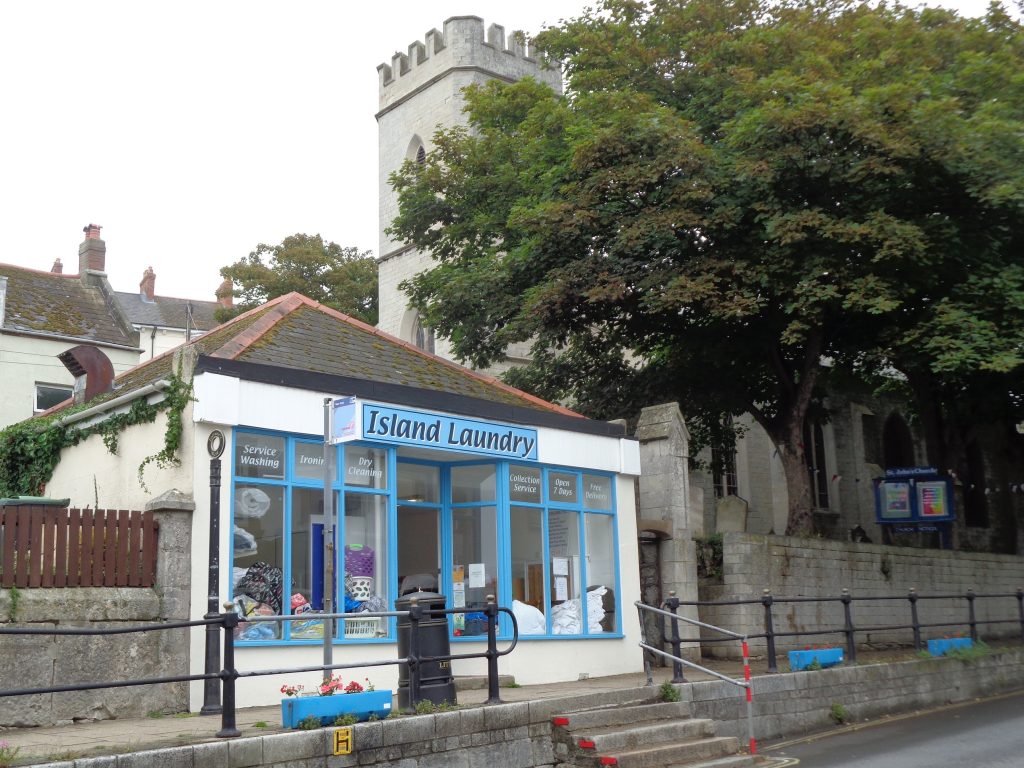
Fortuneswell or Street of the Wells, Portland, 6th August 2020
“. . . Pierston paced up the long steep pass or Street of the Wells. On either side of the road young girls stood with pitchers at the fountains which bubbled there, and behind the houses forming the propylaea[xiii] of the rock rose the massive forehead of the isle – crested at this part with its enormous ramparts as with a mural crown.”[xiv]
August 6th 2020: The distinctiveness of places can be so great that their (also archetypal) atmosphere will strike people of different generations quite spontaneously. Only a few years aer first encountering Portland[xv], did I discover that in The Well-Beloved (1897) Hardy had long since drawn parallels with Italy, Greece and the Rock of Gibraltar[xvi]. In his almost schematic novel, Hardy’s Jocelyn Pierston is a sculptor searching for the Platonic Absolute or Ideal Form of Beauty in three generations of women: Mother, Daughter & Granddaughter. “Creepy!” protested my sister following my misleadingly brief synopsis over dinner at her Abbotsbury cottage.
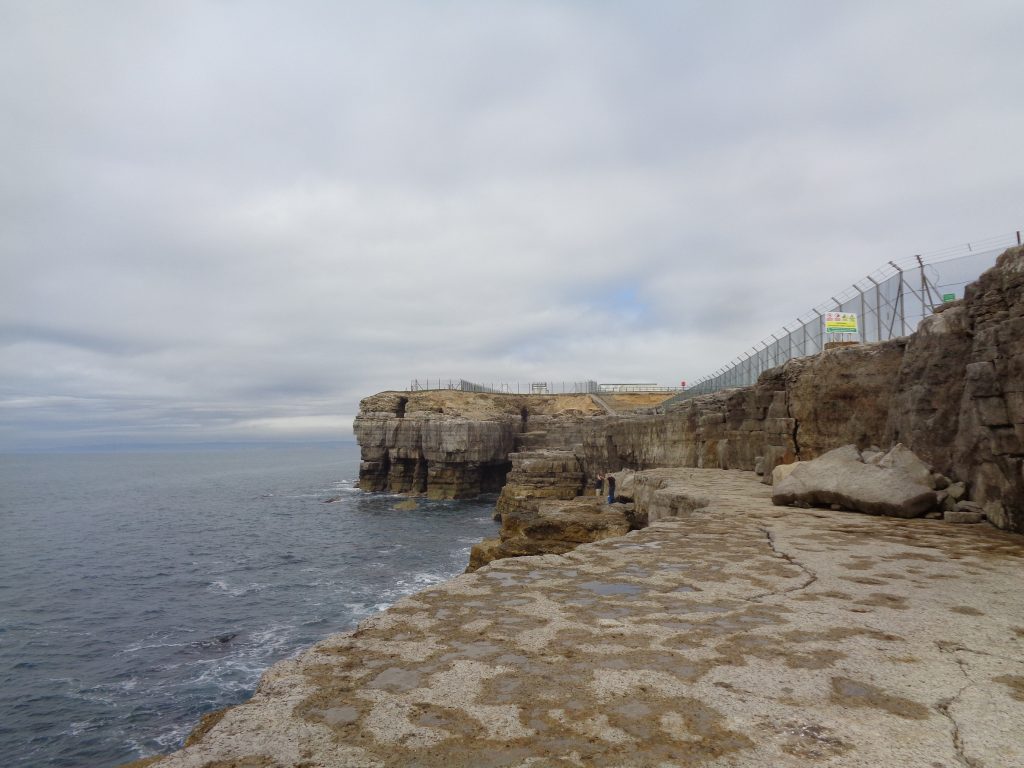
Western coast of Portland just north of the Bill, 6th August 2020 – coastal view of a location used in The Damned to portray the ‘Edgecliff’ military establishment.
Creepy in more political ways, I didn’t consciously discover Joseph Losey’s 1961 film, The Damned (U.S. title These are the Damned) until the early 90s. By far the most thought-provoking film Hammer ever produced, the film does more than contrast the seaside normality of Weymouth with its adjoining island of unfixed time and place. Summoning the primeval and disregarding the compass, it travels far to the south. With its fusings and shiftings of locale – combining sites, depopulating them, mythologizing them . . . The Damned reveals an Ideal Form of Portland, suggesting in many of its backgrounds a Platonic Absolute behind the scarred and now globally dispersed surface[xvii] – the remains of which, post 2000, are tending in the usual direction: toward tourism, museum and theme park. In The Damned, the prehistoric and the apocalyptic become the surface that Oliver Reed in his frantic attempt at escape[xviii], tries to leave behind on the causeway exit near the Royal Victoria Hotel (later renamed the Ferry Bridge Inn).
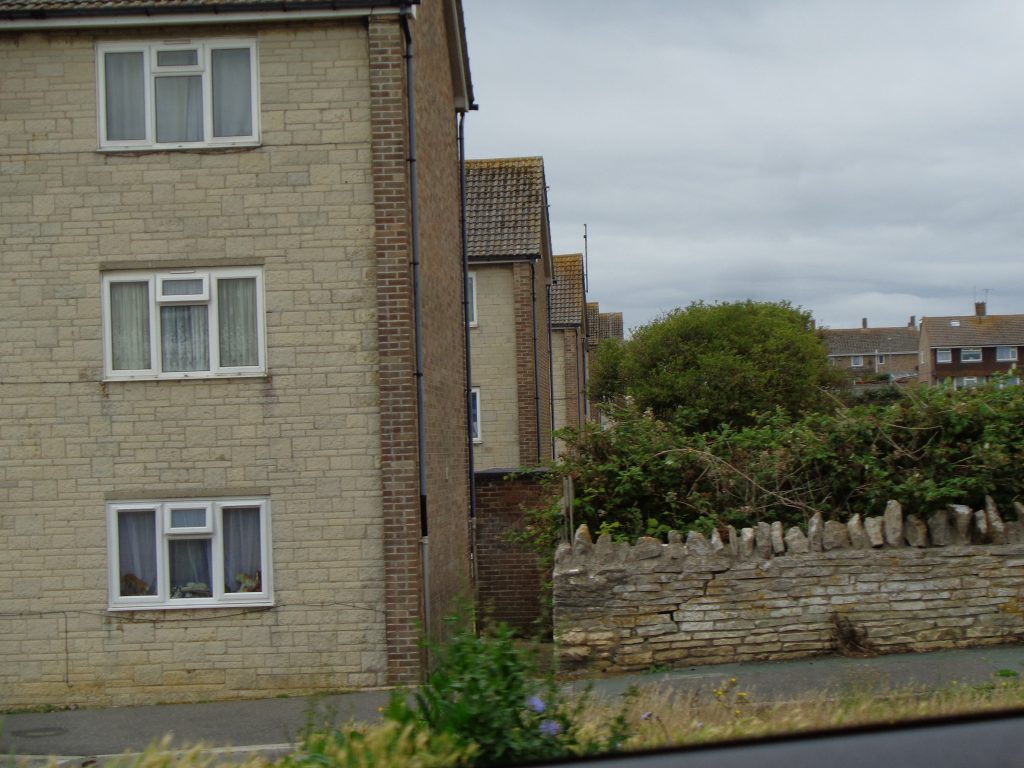
Housing Estate, Weston, Isle of Portland, 6th August 2020
November 14th 1984: Leaving the Isle, there was a roadblock on the causeway. A prisoner had escaped, and even an eccentric on a ruined bicycle was worth questioning. Perhaps the deserter had crammed into his saddlebags, or was using him as a disguise? The questioners are grim and efficient but have nothing to go on. Tilted almost to capsizing, a battleship manoeuvres a tight arc in the silver distance above their heads.
By the far end of the causeway, premature evening is startled by a light of low-angled intensity, blazing its sea away over Moonfleet[xix]. Ten years on, the rickety pier-like bridge here[xx], with its gaunt building alongside, will have been bulldozed into a whisk-past of concrete blandness, a culvert in overdrive. There would be no compassion in this rationalized bridge, its road would become a non-road – just a strip of tarmac to somewhere else – and entry to the Fleet lagoon would go by unsung . . .
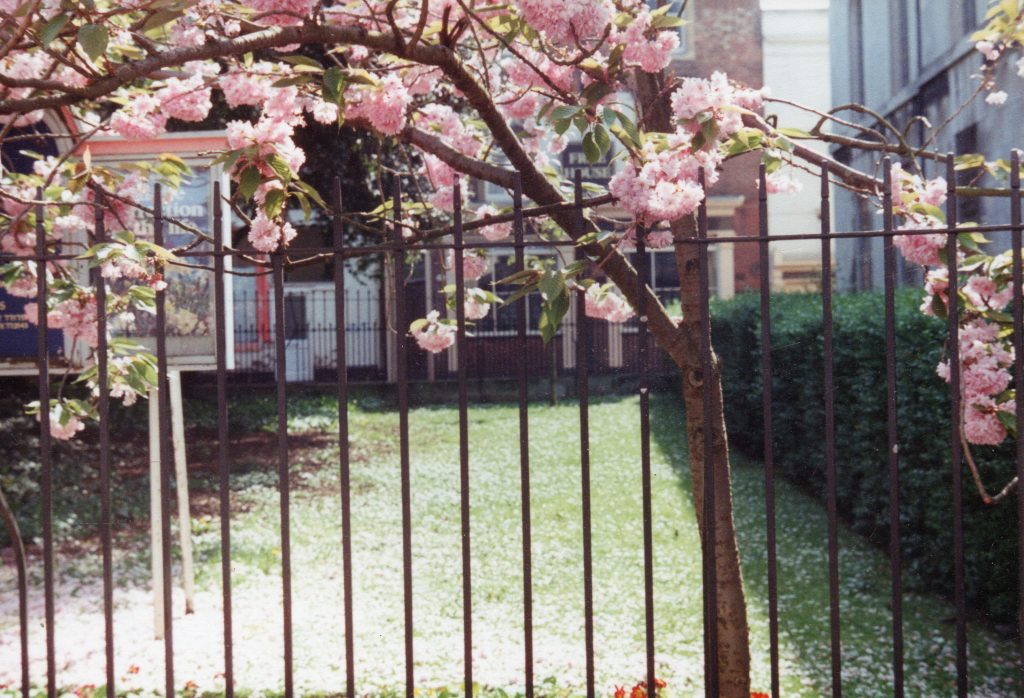
Weymouth, April 1994
In typically whimsical yet powerful fashion, John Cowper Powys, in the third of his ‘Wessex’ novels[xxi], Weymouth Sands[xxii] also drew on childhood memories of Weymouth and Portland. Back in June 1994, K & I enjoyed a two-day Powys Society walk[xxiii] exploring the book’s locations in the town and along the sea front where perhaps not-surprisingly, one of my assigned readings, in competition with the Punch and Judy man down on the beach, involved the dubiously Cockney policeman[xxiv]. The walk went on to the harbour and reconvened the following day to explore the strange semi-island of Portland.
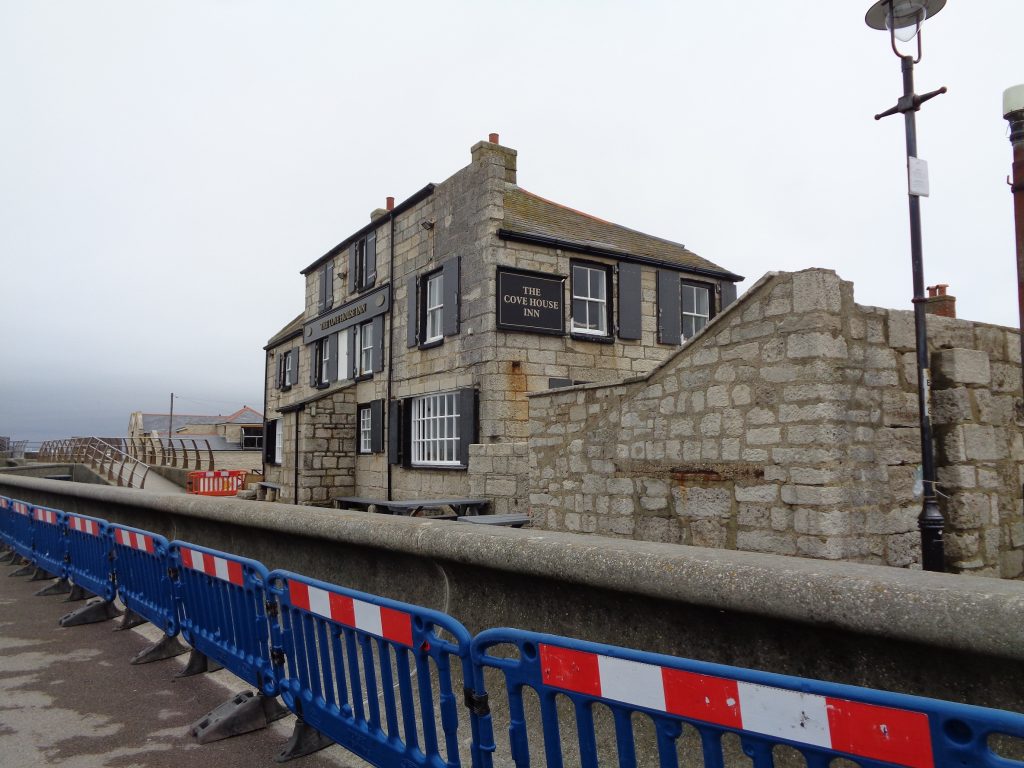
Despite being on the wrong coast, The Cove House Inn, at Chiswell near the eastern end of Chesil Beach and below Portland’s rocky forehead, is assumed as a possible inspiration for Powys’ Sea-Serpent. This was where the walk concluded at the end of its second day. To quote Chris Gostick’s report: “Many fine pictures of shipwrecks decorated these walls, and this was a fitting place to end our odyssey, with a pint or two of local ale and vast plates of crab and prawns . . .”
I remember the ale but not the crab. As we’d been carrying our one-year old son, I think we had to leave.
Chris Gostick sums up Weymouth Sands admirably: “Weymouth Sands, of course, is about much more than a sleepy Dorset seaside town. Written in J.C.P’s last months in America, its spirit of place, the meeting between land and water, between the visible and the invisible, the known and the unknowable, provides a focus for his own personal life as he contemplates his permanent return from the New World to the Old, as well as a fulcrum on which his imagination can pivot.” He continues: “By appreciating the accuracy of his recreation of the town of his childhood, we also begin to recognise that its description relates increasingly to the town of his imagination, with its unrequited passions and ambiguous relationships, which in turn mirror the passions and linkages of his own life.”
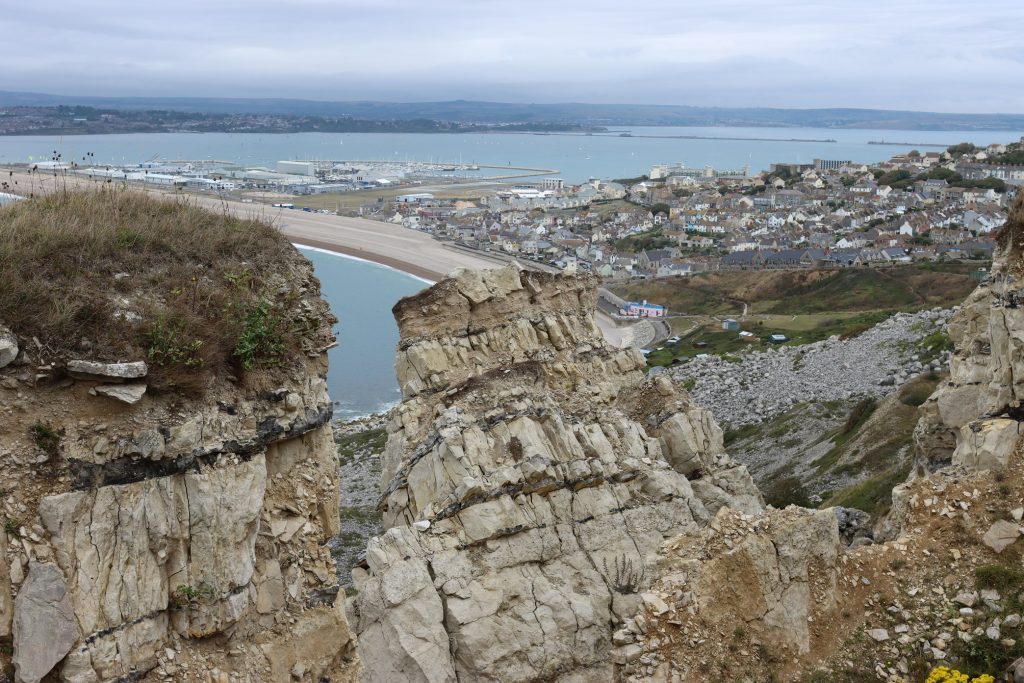
Landslip above Hallelujah Bay, Isle of Portland. (photo: Jem Freiesleben)
Climbing through Fortuneswell away from the beach and the causeway, at the summit we found that with the foreground addition of the fragile looking Olympic rings[xxv], the tremendous northward prospect has become very popular as a photo stop.
Tout Quarry Sculpture Park[xxvi], designated a nature reserve in 2013, has also become very busy compared to the 1990s. In the maze of paths that emerge onto the western cliffs and the landslip captured above, it was good to encounter some of the stone carvings so well remembered.
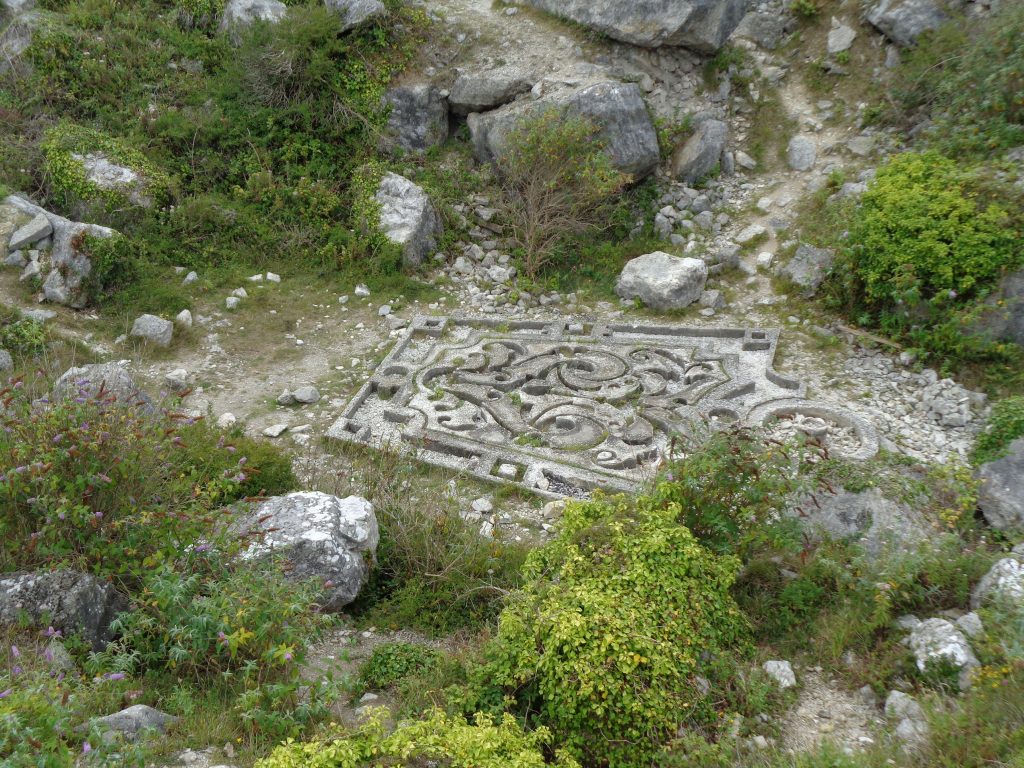
Full sun broke out as we reached St George’s Church . . . just in time to give the land a sudden Mediterranean aspect of whiteout and sight blindness. Though it didn’t show well in photos, the sea had switched from grey to crystal blue.
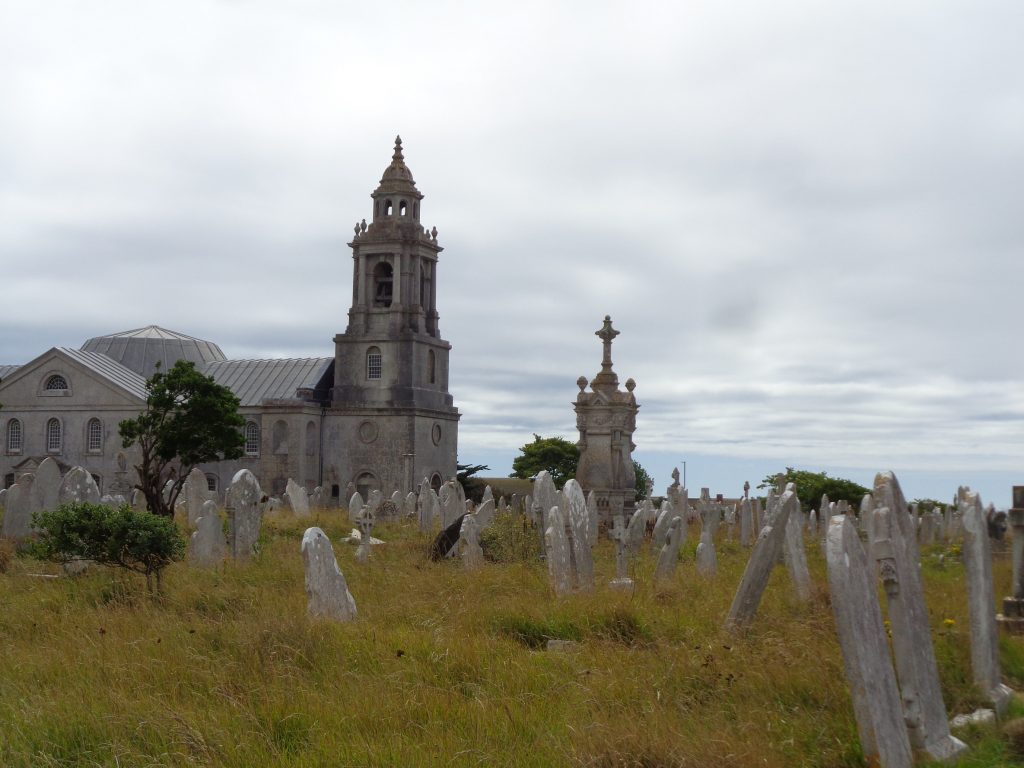
Saint George’s, Portland, August 6th 2020 – Mediterranean under the sun – a location evocatively used by Joseph Losey in The Damned (1961).
On the Bill itself, tipping into the sea, the atmosphere was one of festival – as if a cheerful Sunday common in London, once decorated with lighthouses, cafes and exotic plants had then been inundated by the sea. Trippers, picnickers, cyclists, hikers and fisherman, all congregated in the eye-blinding heatwave, expanded by a merry anarchism, with barely a facemask in sight . . .
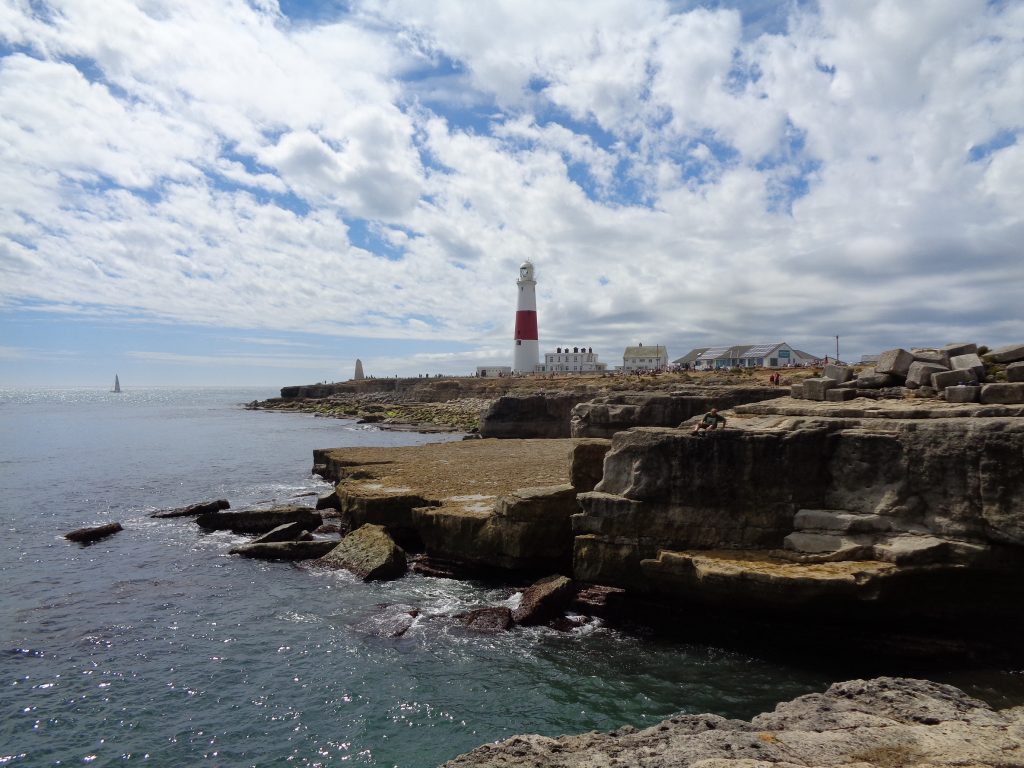
Portland Bill, August 6th 2020
Rereading The Well-Beloved at close to the age of its main character (60) as the book closes, is bound to reinforce the passage of time since my first reading in 1986 – despite that (escaping our chronological conditioning and the sheer inconsequence of modern life) certain events of 30 or 40 years past, can feel more immediate than last week. Although the hints of landscape and local history hold their power – knowing the place before the book, might promote this aspect – The Well-Beloved’s essentially sketchy nature does not hold up well. Most of the characters are close to ciphers. Does The Well-Beloved foreground the abstract at too great a cost? Yet the way Pierston sees himself in the mirror, at the age of 60, “too grievously far, chronologically, in advance of the person he felt himself to be” is painfully accurate. I have the same feeling every time I accidentally catch sight of myself in such a way – of a “fossilized relic in human form”[xxvii].
Paradoxically however, the theoretical, abstract, texture of The Well-Beloved, also limits my disappointment with it by comparison with other renewed encounters with supposed classics in varying media[xxviii]. Even the undoubtably great (and vastly underrated) Weymouth Sands, appears less than the sum of its magnificent parts. As is so often the case, what one can imagine from memory or from hyperbolic synopses or reviews, can be infinitely greater than the reality – as if the imagination senses the potential beyond the surface or any number of hidden subtexts; as if the imagination comprehends some ineffable essence.
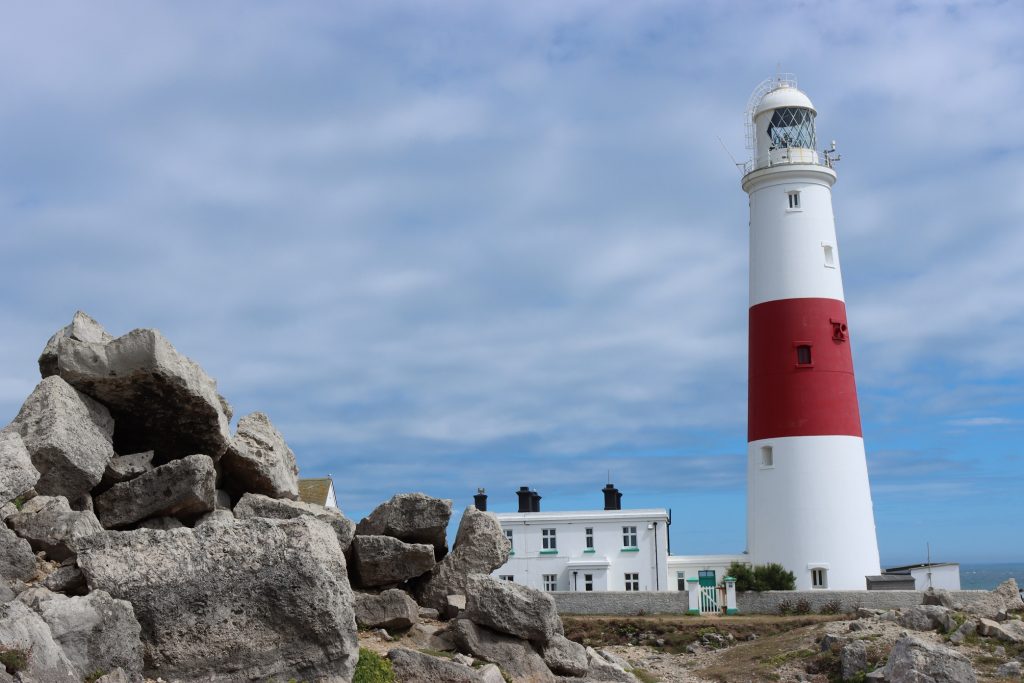
Perhaps the most distinctive character in Losey’s The Damned is Freya, the sculptress (or sculptor if you prefer) played by Viveca Lindfors. Despite limited screen time her atypical world view is very clear. “I like him because he doesn’t like the world,” she immediately notes of American protagonist Simon Wells (Macdonald Carey), and while she dismisses her lover Bernard’s suggestion, that he has become old and ugly, she is fatally pained that he has become ugly ideologically.
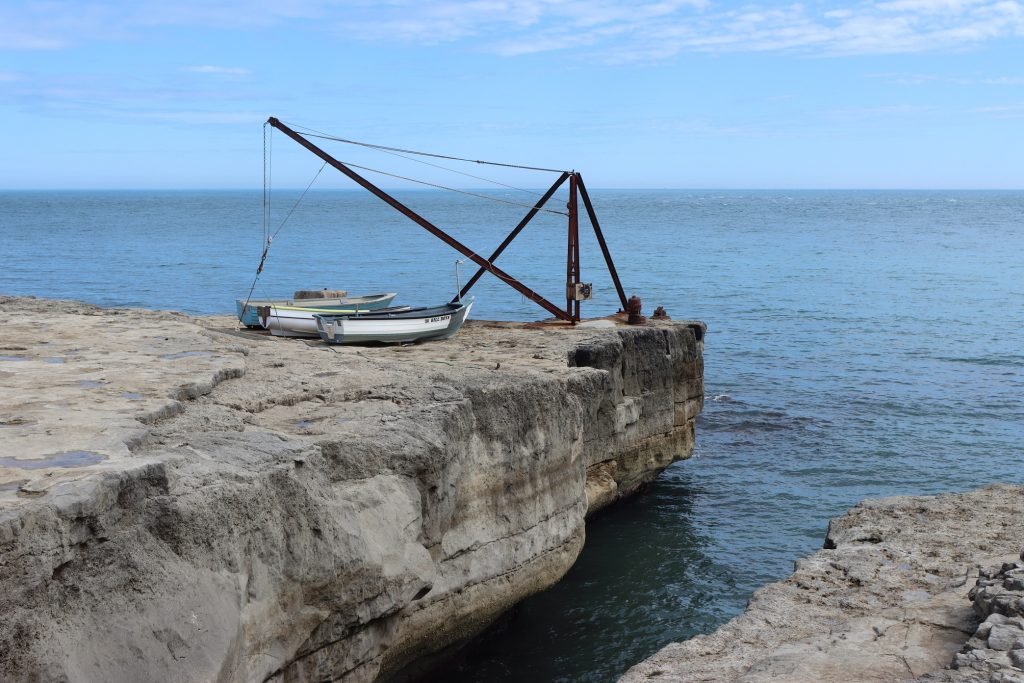
Portland becomes Crete
Between H.L. Lawrence’s The Children of Light (1960)[xxix] – sidelined source novel for The Damned – and 1962’s A Clockwork Orange[xxx], by flamboyant author Anthony Burgess, there exists little similarity. Overt links between Losey’s uneven but fascinating film adaptation and Kubrick’s well-acted but overrated, A Clockwork Orange (1971) are also scarce. But watched back to back, if the viewer isn’t distracted by the latter film’s visual over-style and shock tactics, it’s uncanny how Alex (Malcolm McDowell) and his droogs can be seen as an escalation of King (Oliver Reed) and his gang of Teddy-boys[xxxi] – a resemblance which may be purely coincidental despite Kubrick’s skill at putting old wine in new bottles[xxxii]. In contrast to A Clockwork Orange, which (like Eyes Wide Shut of 1999) remains over-extended and on occasion, tedious, The Damned is becoming one of those films whose imperfections may contribute to its quality. At times, Shirley Anne Field seems younger and more wooden than the actual children of light (whose dressing gowns with strings, suggest monks), but did these moments arise deliberately rather than as a result of incompetence? With hindsight such uncertainties appear as ideal as Kim Novak’s casting was for Vertigo (1958). As with the Portland landscape itself, Shirley Anne Field’s tonal shifts echo or pre-empt all the landslips in the film itself. By conventional film standards these may seem clumsy, arbitrary or abrupt, but in fact they are like our concentration, our changes of mood and effort, our aspiration or apathy, our determination or despair in life itself. Do we accept ruinance or try to counter it? Then there are the dubious back-projections. Weirdest of these are the floating coastal views from the Ministry’s high-wired, Edgecliff establishment, (at 29.47 NTSC) with its shifted prospect of the causeway and the oil refinery[xxxiii]. The way the room slides forward suggests a flimsy Crittall-windowed spaceship coming into land on an alien planet! The simplistic Black Leather Rock theme is also something viewers will either love or hate. Yet in the end, the film lodges in the memory for its incredible locations and photography, and for its ideas and warnings, the horror of its imprisoned, guinea-pig children of light.
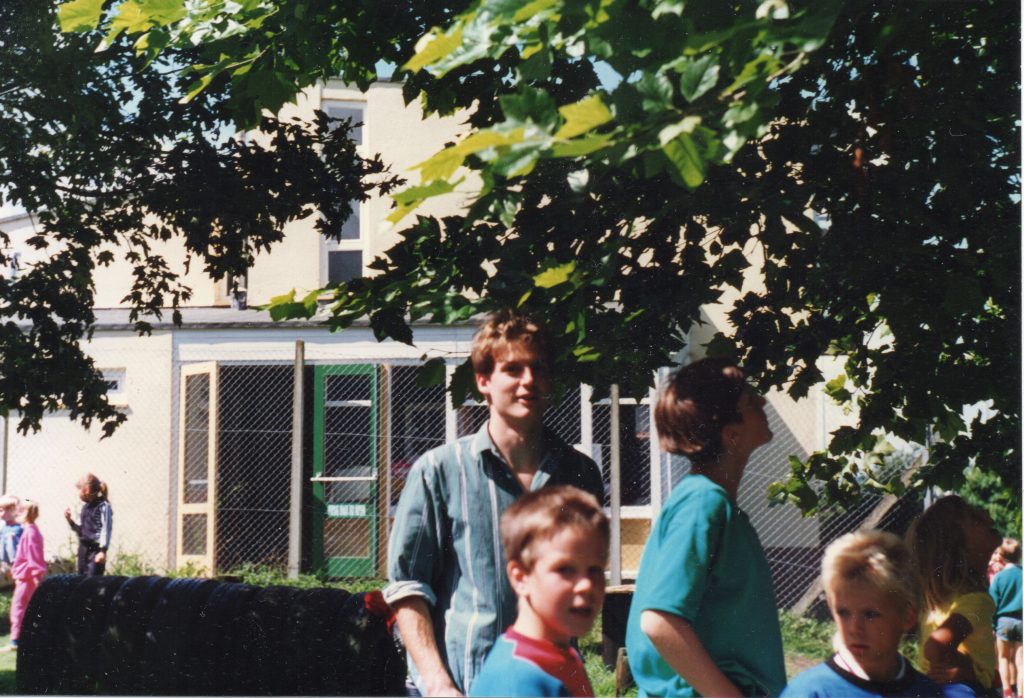
The Honiton Youth Club summer playscheme in July 1988, children in the sunlight . . .
Thirty-two years later, on the 5th August 2020, it was impossible to match the angle to

illustrate the Now to the Then above it – this awkward photo only showing the back walls from the side. Although the large doors to the playground still exist facing the fence, the sole or best reference point is the vertical upstairs window visible in both photos. The adventure playground itself has long gone, its traces ovewhelmed by the scrub and brambles beyond the locked fence. At least the building survives – albeit in rundown form and subdivided inside. According to the internet it was still operating as a youth club until the lockdown in March, and survives as a community building[xxxiv] but with the vast decline in youth service funding (70% in the last ten years) this must be largely or entirely on a voluntary basis.
In The Damned, King’s main sidekick in the gang, Sid, (Kenneth Cope of Randall & Hopkirk fame), confessess to Freya that “it’s kids stuff knocking about in a gang, but what else is there to do? “What would you like to do?” the sculptor asks, and Viveca Lindfors condescending tone of voice is also open to concern. For all its underwritten nature, was this Lindfors’ greatest part?[xxxv] Elisabeth Frink[xxxvi] who provided the apocalyptic artwork may have been on set to direct her movements, but Lindfors is totally believable as the high-principled, anti-establishment sculptor. Sincere yet ironic, cynical yet passionately optimistic, her character deserves a film to herself. Alexander Knox is also convincing as her heavily compromised Establishment lover and patron, calmly maintaining some kind of pragmatic stance. Of the nuclear fiddlings of scientists – one of which inadvertantly created the Children of Light – he says, “I don’t need to tell you that there are such accidents. Three hundred in the last fifteen years. That, is a fact.”[xxxvii]
Sidekick Sid obviously lacked the kind of opportunites once more freely provided by youth clubs. Such psychological aid was always as valuable as the apirational regimentation and competition ranking of schools, yet without the grades or pieces of paper, has only personal testament to speak its name. If not ruinance[xxxviii], that there’s been a 70% decline in funding over the last ten years[xxxix] clearly illustrates the ruination going on here. As always, to compensate for yawning need and the the huge human shortfall, Society relies upon the supposed advantages and convienencies of technology to fill in the blanks – which it will always signally struggle or fail to do. Rural poverty, meanwhile, is no less serious than urban[xl], the consequences are just more camouflaged.
As a trained Youth Worker I always retained an awkwardness in the role. Avoiding all clubs myself as a teenager, to me Youth Clubs were for goody-goodies or where you had to accept patronisiation by middle-class do-gooders, a kindness to keep you off the streets. This personal predudice took a long time to erode and will always have some elements of truth. Until paid jobs in such fields dried up in the 1990s, I largely worked as secondary support. At Honiton, with a well organised Youth Leader in charge (the old job titles do sound dubious, almost Hitlerian), the character of mildly anarchistic sidekick suited me well and our combination appeared to work perfectly – breaking down the ‘Us versus Them’ principle common at least in the minds of more working class kids? Age-wise the gap couldn’t be entirely banished – but between the streets and the Establishment, the ‘hoodlums and the do-gooders’ (!) it was mediated.
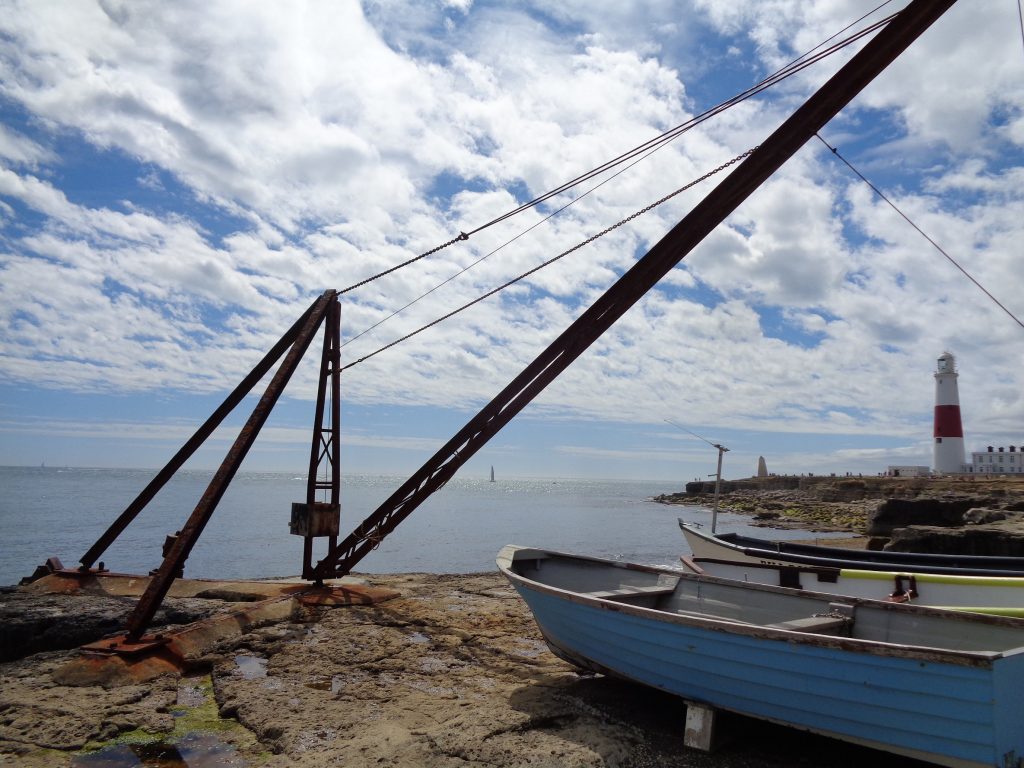
Leaving the old Youth Club behind, at the end of our[xli] brief return, I was flooded with memories of an area and time in which the whole course of my life changed. Meeting K there, turned Honiton into a legendary place for me, and cast the end of the 80s as its heyday. It also felt as though it was only a few weeks ago: that this overcast, early August evening was autumn to a summer just ended.
Seeing a group of children up nearer the town, hanging around on scooters and bikes, I imagined that I might recognise them – before realising that these children would be their children, or even, just possibly, their grandchildren. Like the three generations of women through which Jocelyn Pierston followed his Well-Beloved, these could easily be descendants of those I once knew, stranded in a childhood that would only be partially recognisable to their forbears . . .
Clearly, we need books, films, music and art to widen our lives, and often enjoy them without realising how much we exist and satisfy ourselves through them. Therapists might aim to help people discover and realise their unmet needs, as if, were that possible, we could all become entirely happy and be able to leave our varied traumas behind. But the truth is that life will always be a chain of unmet needs, and the more widely we experience things, the more this hunger, this aspiration expands. How valuable might it therefore be, to contemplate our alternative lives, those paths we did not take, those lives which are far more plausibly connected to us, connected from the inside, than the stories and hopes gained from outside. As the characters in films and fiction can give the impression of lives that go reassuringly unchanged[xlii], couldn’t our own alternative lives offer the same relief – changing or unchanging as we choose, making a more satisfying story?
In The Damned, one military lackey comments that all Freya’s sculptures look unfinished. “Well now, isn’t everything in life sort of unfinished?” she replies[xliii]. That nothing can be finished defines part of life’s ruinance. This is another fundamental anxiety we must constantly resist, consciously and subconsciously . . . which is very tiring.
Briefly, leaving Honiton, I had that feeling of being stuck “in the prison of time”[xliv]. For an hour I wished I could be back in 1988 and 1989 and have all my time of then[xlv] – the people, the landscapes of Honiton, Sidmouth, Exeter and Dartmoor – all over again, even as a Nietzschean Eternal Recurrence. What rescued me from this caging mood was the remembrance of all the forking paths our lives contain, all those other possibilities. Everyone is rich with them. It’s always too easy to feel burdened by the less good days, the tedious and pointless hours which constitute most of our lives, to feel imprisoned in the passing present . . . but surely such habitual or conditioned cancelling is destructive? Instead, an imaginative appreciation of the way things might have gone, of abandoned or seemingly impossible directions, can evade the blind end of life. Stories branching from the self surely only enhance the fabric of now, this gathering of threads, real or ideal. From my first encounter with The Isle of Slingers in 1982, right up to August 2020, elusive moments and thoughts form a expanding crown – the truth for which a parade of realities are merely rough versions[xlvi].
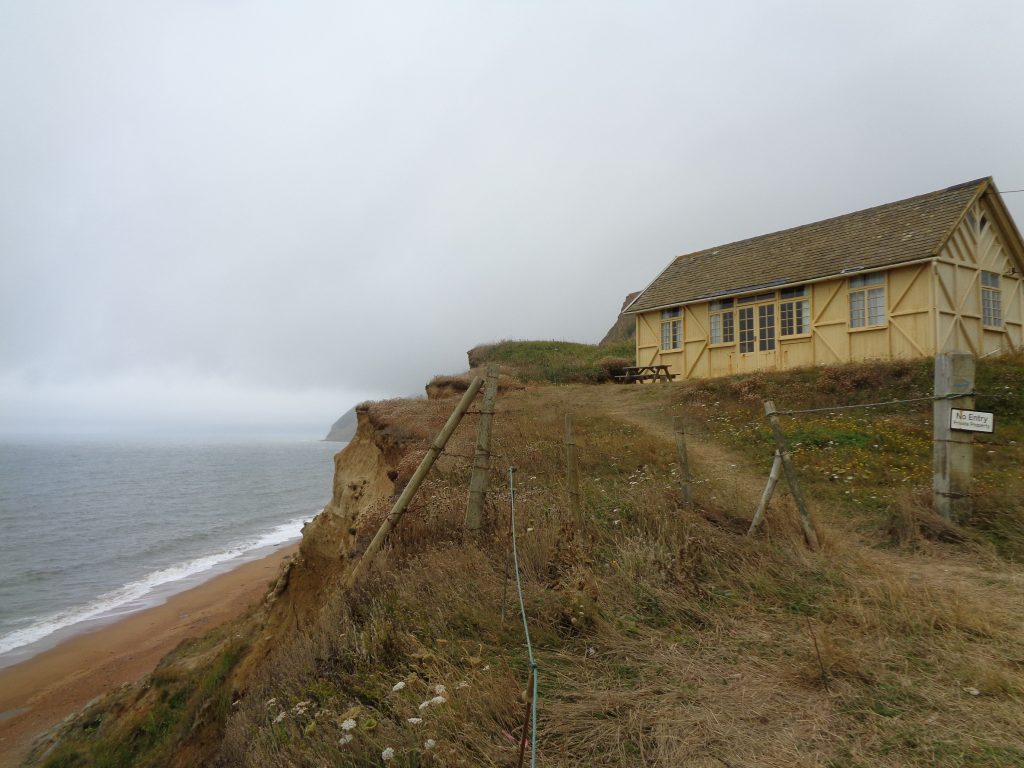
Eype’s Mouth, Dorset, 5th August 2020
This chalet at Eype’s Mouth, not far beyond the western end of Chesil beach, was the first place in Dorset I lived back in the autumn and winter of 1982 and 1983. In contrast to the decline in the Honiton Youth Club, the deceptively flimsy-looking structure seems virtually unchanged. The colour scheme remains identical and it appears no closer to the cliff edge than it did 38 years ago. In winter storms the roof tiles used to ripple, the wind blow right through the cracks in the doors and the noise of the sea was loud. I often dreamed of waking up in the waves. The building had never been let for winter use before and may never have been again. But on sunny days the atmosphere was unmatched. With the Isle of Portland visible to the left and Start Point far to the right, I had a table for writing and painting immediately behind the central double doors and except during storms could walk along the beach to West Bay, or along the cliffs to Thorncombe Beacon and Golden Cap – highest point on the south coast[xlvii].

Vipers Bugloss, Tout Quarry, Isle of Portland, 6th August 2020
If the idealization of a person is a fiction in advance or retrospect – or yet a life-long process, a perennial sympathy – if it’s based on their hidden or unused potential, then it may come to embody those paths otherwise untaken, may project what we missed. Can the most powerful nostalgia be not for the (highly subjective) realities of what actually happened, but for what might have happened?
Indulgence has its value, even self-indulgence. It might be suspected that such a statement merely aims to spike the guns of critics keen to disparage the memory-lane Digression, but as it follows that without risking portentousness we may stifle aspiration, so without indulgence and self-indulgence we risk stifling the veracity beneath emotion. Which is true, the dead-of-night anguish or the daylight’s reassurance? Excoriation or indulgence? As with everything, finding the balance is what’s important . . . and balance points are always shifting.
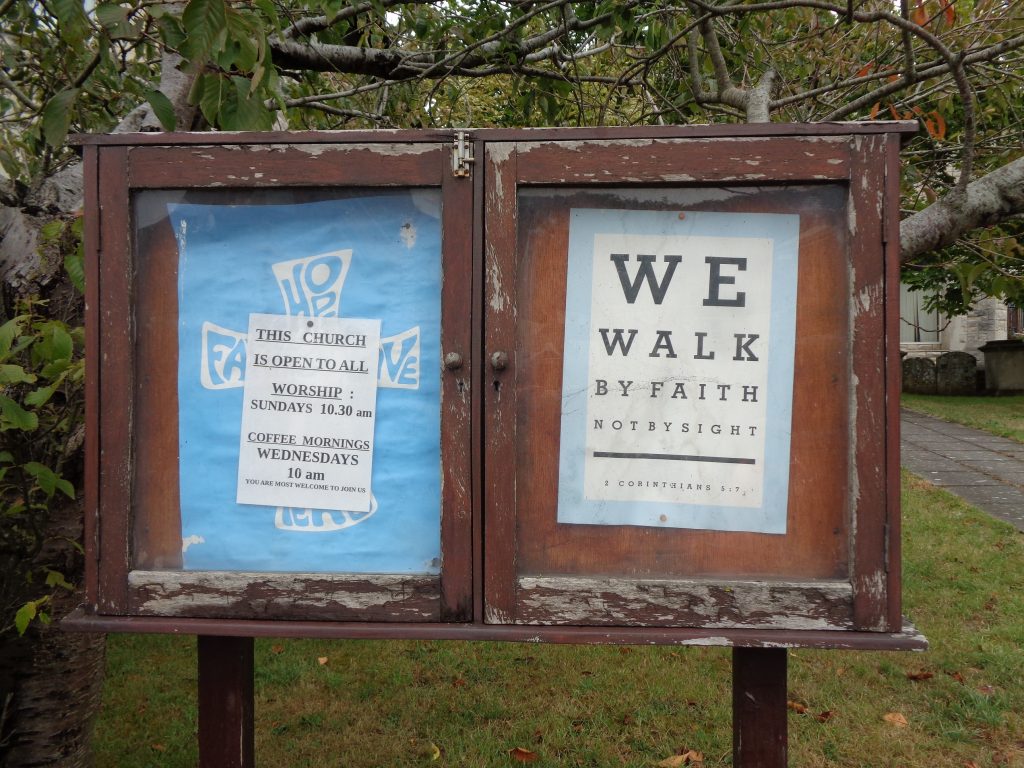
“WE WALK BY FAITH, NOT BY SIGHT”. Underhill Methodist Church, Fortuneswell, 6th August 2020
While the slight disappointment of The Well-Beloved was offset by the landscape and flawed grandeur of The Damned, another recently re-watched film fits perfectly with the themes of lost potential and nostalgia. I first saw Melody (1971, directed by Waris Hussein) under the original title S.W.A.L.K.[xlviii] on a double bill with The Railway Children (1970). About to go to a school where I’d have no friends and be forced to wear a stupid uniform, the anarchism of S.W.A.L.K. (despite its title) inspired me to find the prospect of this life-change bearable – imagining myself as Jack Wild’s Ornshaw, indomitable, yet kind underneath. Like thousands of others, I had half a crush on Tracey Hyde[xlix] – about my age by the time I caught Alan Parker’s story and screenplay at the local Odeon. Years later, the film became important again, for the entire era it encapsulates[l]; for a London only half-a-brick’s throw from places I used to live and regularly visited; for the simple (if illusory) sense of potential. As opposed to the humorously caricatured adults, the reality of the children, all the children – their faces, their brilliantly filmed[li], flowing/unflowing movement, their resignation or freewheeling defiance – all are unforgettable . . . and somehow even deepened by the treacly, yet now eloquently poignant music: songs by the Bee Gee’s for heaven’s sake, long before the days of Meaningless Songs in Very High Voices[lii]. Also, with perfect serendipity, the seaside paradise to which the young lovers of Melody escape, ten years later and now in colour, is the Weymouth of The Damned[liii]. These children are the children that all the Children of Light, imprisoned in their cave, had the right and the potential to be. Though Melody the girl and her equivalents have become inaccessible ghosts, seen in the right mood, Melody the film, is flawless.
But perhaps the ‘potential’ that really haunts me is a latent quality that cannot ever be achieved in this life. I’m not talking about earning potential, learning “how to smile as you kill”[liv], reaching our educational goals or even about self-actualization[lv]. If it didn’t sound unfashionable or insane, the potential I’m referring to is akin to the essence or soul – which is of more significance outside this inconsequential world than within it[lvi].
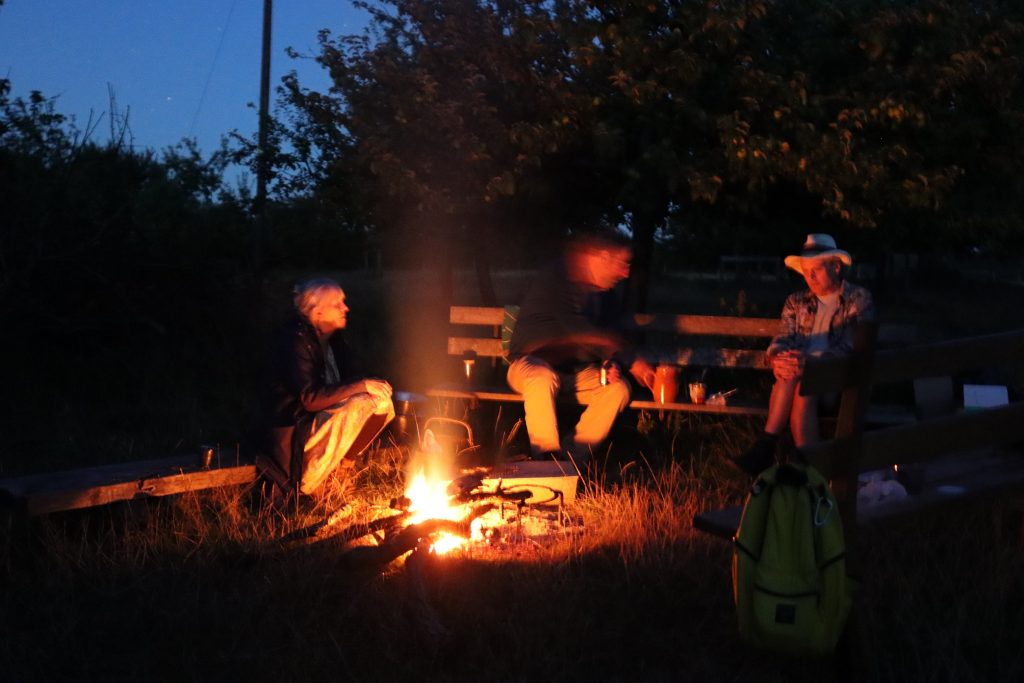
Nettlecombe evening, 6th August 2020 (photo: Jem Freiesleben)
Attached to every place I’ve lived, beneath the layers of ‘reality’ and of idealisation, there are more elusive stories: people always but never known; lives and places we could have had. From both the shades and the clearer friends, comes a richness which defies surface melancholy; defies the inevitably time-filled regret of anyone who thinks or feels deeply. At some places this richness blossoms particularly strongly, despite that their present surface may appear determined to exclude their past. For me two such areas surround Bideford and Honiton. In a way they and the people of thirty or forty years ago have become innaccessible ghosts. But also, in another way, they are always with me.

Honiton revisited, 11th July 2003
The same people in different circumstances; the way that with better luck, things might have played out – lives adjusted, neuroses ameliorated, a greater sense of freedom . . . Am I just anticipating our subliminal ‘potential’ beyond a far too inadequate existence? Is it only the thought of such possibilities which makes people of a certain temperament (more thoughtful or less grateful, always discontented with the inconsequence of life), able to survive over time? To be in many places at once. This is the richness. All the links: the what was, combined with the what might have been . . . to me they are all beginning to blur in a good way.
© Lawrence Freiesleben,
Dorset & Cumbria, August 2020
[i] Thomas Hardy, The Well-Beloved (1897) Part 2, Chapter 3.
[ii] From Maze End chapter 16 – A Quiver of Arrows/Revisited Islands, part vi – The Isle of Slingers, – based on a cycle of November 14th, 1984.
[iii] Thomas Hardy, The Well-Beloved (1897) – a passage only subtly rephrased from his 1892 serialisation
[iv] https://en.wikipedia.org/wiki/Chesil_Beach
[v] Genuine sailors and others who enjoy boats – with or without sails – would recognise this unfortunate mutation.
[vi] From Shelley’s Prometheus Unbound – as invoked by Thomas Hardy at the opening of The Well-Beloved (1897)
[vii] https://en.wikipedia.org/wiki/Tout_Quarry
[viii] https://en.wikipedia.org/wiki/Derry
[ix] During a month-long walking/hitchhiking tour of Ireland in May 1984, my sister and I had spent the night at Coleraine staying with a schoolfriend of hers. On the morning of the 15th we took a train to Londonderry and after exploring the city, caught a bus to Ballintra. The border was very obvious with block houses and armoured vehicles, the bus carefully searched and scanned with bomb detectors and mirrors. The checking of passengers, though not stringent, was intimidating in atmosphere. We had been told it was safer to cross the border by public transport rather than walking or hitching . . . 4
[x] The Well-Beloved, Part Third, A Young Man of Sixty. Wordsworth Classics edition, page 107: “though many who had formerly projected their daily shadows upon its unrelieved summer whiteness ceased now to disturb the colourless sunlight there.”
[xi] Quite probably used as the ‘Edgecliff’ military establishment in the The Damned – a location that also features in Night of the Big Heat, see: www.reelstreets.com/films/damned-the-1963/ capture 28. This former Transmitter Station adjoins the old nuclear attack observation, ‘Rocket Post’ named on the OS Map which closed in 1991: https://www.portlandhistory.co.uk/roc-post-portland-bill.html
[xii] Ibid. Maze End chapter 16
[xiii] “The propylaeum was the entrance to the Acropolis at Athens”. Hardy’s link is perhaps even more forced than some in my Digressions? Amusingly, at the top of Fortuneswell, at the junction clearly described in The Well-Beloved, where Verne Hill Road branches off the main ascent of New Road, there’s a block going by the name of “Joslin Court”.
[xiv] The Well-Beloved, chapter 9.
[xv] https://en.wikipedia.org/wiki/Isle_of_Portland
[xvi] Although the limestone of Gibraltar (https://en.wikipedia.org/wiki/Rock_of_Gibraltar) doesn’t taper so gradually, there are similarities with Portland’s limestone projection, including the red & white lighthouse at Europa Point, from where Africa is visible across the Straits.
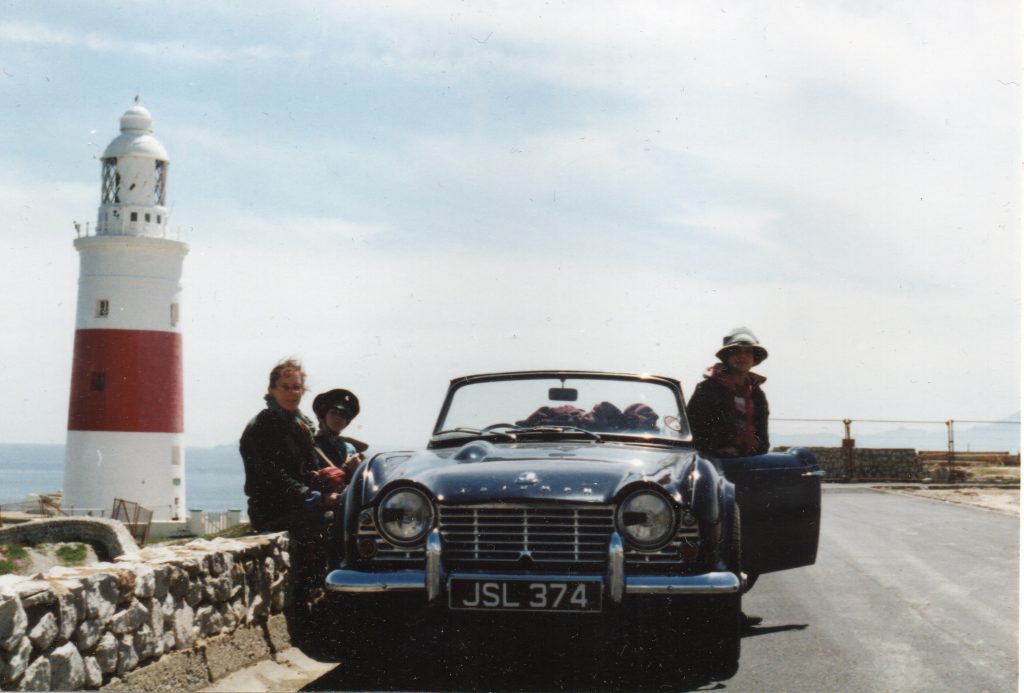
Europa Point, Gibraltar, 14th April 2008,
[xvii] https://en.wikipedia.org/wiki/Portland_stone
[xviii] www.reelstreets.com/films/damned-the-1963/ See particularly, screen captures 36 and 37.
[xix] Another great film which shares a key member of the cast with The Damned: Viveca Lindfors. Though based on J Meade Faulkner’s Dorset-centred book, Lang’s Moonfleet (1955) was filmed either in the studio or on the Californian coast. The filming doesn’t seem to have been a great experience for anyone involved, see: https://moviesalamark.com/2017/08/10/moonfleet/
[xx] Ibid: www.reelstreets.com/films/damned-the-1963/ Captures 36 and 37 again.
[xxi] https://www.goodreads.com/series/156174-wessex
[xxii] https://en.wikipedia.org/wiki/Weymouth_Sands See also: https://www.jstor.org/stable/26106696?read-now=1&seq=4#page_scan_tab_contents
[xxiii] See the Powys Society Newsletter No 23 of November 1994 for a report on the event written by Chris Gostick: A Walk on the Sands.
[xxiv] Anticipating the stock Hollywood, London ‘bobby’ – later employed (for example) in Universal’s 1940s series of Sherlock Holmes adventures.
[xxv] https://www.bbc.co.uk/news/uk-england-dorset-44818785
[xxvi] https://www.portlandhistory.co.uk/tout-quarry-sculpture-park.html
[xxvii] The Well-Beloved, Part Third, Chapter 4.
[xxviii] While The Damned, despite its obvious flaws, exceeded my expectations, so many previously admired or newly recommended books, films etc., have been sadly disappointing. While in certain moods, obvious trash can be entertaining in a perhaps essential human way, if we lived for a thousand years, how much ‘art’ would quickly reveal its inconsequentiality compared (for example) to the experience of just being in the landscape? The survival of The Damned in my estimation may owe much to the vividness of its landscapes and townscapes.
[xxix] See Tim Lucas’ useful and characteristically concise blog entry on the book and its relation to the 1961/2 film adaptation: https://videowatchdog.blogspot.com/2016/09/on-reading-children-of-light.html
[xxx] https://en.wikipedia.org/wiki/A_Clockwork_Orange_(novel)
[xxxi] A resemblance also noted by Marcus Hearn in his comprehensive and incisive DVD viewing notes for The Damned – a film he calls “eerily prescient.”
[xxxii] See Eyes of the Beholder, a Sight and Sound Article of Dec 2019 by Hannah McGill written for the 20th anniversary of Eyes Wide Shut (1999). In a sidebar, Frederic Raphael reminds us that Barry Lyndon (1975) was derived from William Thackeray’s 1844 novel, while Eyes Wide Shut had its source in Arthur Schnitzler’s Dream Story (Traumnovelle) of 1926 set in 1880s Vienna.
[xxxiii] Now replaced by light industrial units and the large Lidl supermarket previously mentioned.
[xxxiv] https://www.midweekherald.co.uk/news/honiton-s-youth-centre-offered-a-lifeline-1-3775455
[xxxv] Lindfors had another fascinating role in the semi-mystical melodrama Night Unto Night (1949) of
12 years earlier, starring opposite Ronald Reagan no less! Night Unto Night begins confidently, exceptionally even, only to peter out like the half-hearted tropical storm it concludes with . . . As for Reagan, judging from his relatively sympathetic film roles of the 40s, it’s easy to believe that he became reactionary and childishly naïve with age. Looking back, (at least hazily from this side of the Atlantic), he seemed shadow puppet to the fundamentally more callous Iron Lady, Führerin Thatcher. Nowadays, with Boris as half-witted puppy to Trump’s arrogant bigoted gangster, the roles appear to have switched continents.
[xxxvi] https://en.wikipedia.org/wiki/Elisabeth_Frink
[xxxvii] At 1.26.45 NTSC or 1.21.50 PAL – figures taken from reality.
[xxxviii] See: http://internationaltimes.it/the-italian-digression-part-8/
[xxxix] https://www.fenews.co.uk/fevoices/40780-1-billion-decline-in-funding-for-youth-services-in-10-years
[xl] Letter of 2014 to the (Female) Youth Leader at Honiton from a woman who went there from age 14 in 1987 to 1990: “Honiton and being a teenager all seems a very long time ago but I’m always so glad for the Youth Centre. So many of those kinds of refuges and stimuli for young people have gone. I teach our local Scout group crafts occasionally and leaders say the numbers are so much lower than ten years ago – children staying home to use their computers either for leisure or due to ridiculous academic pressure. Most of the small towns round here have deprived estates on the edges – filled with children who wouldn’t be seen dead as a Scout. There just doesn’t seem to be time for growing up if you conform to all that ‘education’ requires, and as for those who have little chance of doing that, there is nowhere to go.
[xli] On the trip from Cumbria to Dorset and Devon I was accompanied by my son Jem. Jem was neither impressed by “once hopeful architecture” nor “legendary” (my descriptions) nature of the Youth Club building . . . but as I pointed out, without it, he would not exist!
[xlii] https://www.imdb.com/title/tt0039745/?ref_=nv_sr_srsg_0 The events of Quiet Weekend (1946) for example, are always the same, while John Buchan’s dry-fly fisherman still lives in that same “pretty cottage with a lawn running down to the stream, and a perfect jungle of guelder-rose and lilac flanking the path” (The Thirty-Nine Steps, published 1915)
[xliii] At counter time 1.05.23 PAL/1.10.09 NTSC
[xliv] http://internationaltimes.it/the-italian-digression-part-8/
[xlv] Two excerpts from http://internationaltimes.it/donnie-darko-a-digression-on-universality-and-inevitable-nostalgia/ (internal notes removed): “We can time travel in our mind any time we want. My living memories of Honiton are time travel.”
“Although this was a town in the West Country, a fair proportion of those who came to the youth club lived on deprived estates. Yet the landscape was beautiful and 1988, 1989 and 1990 blessed with long periods of rich summer light. High hill ridges encircled the settlement, over which to the south, the sea under red cliffs, wasn’t far away. There were even small pockets of suburbs almost as wealthy as those depicted in Donnie Darko – suburbs through which we could cycle, and golf courses where we would be disapproved of. At twenty-six I wasn’t so old that it was impossible to go back, to relive that opening of potential again, alongside those still closer to it.
[xlvi] From: As the Landscape Loses Focus, Inevitably, it Gains in Mystery. Completed in July 2020
[xlvii] https://en.wikipedia.org/wiki/Golden_Cap
[xlviii] Which title explains why the film ends with the so-called ‘Crazy Credits’ listed by IMDb: “Love Melody xx x”. Clearly, as if she is endorsing a memory, Melody is sending the film to us, the audience.
[xlix] Who despite a few TV appearances made only two other films – notably The Orchard End Murder (1981), which the press notes described as: “a macabre tale of a bizarre encounter between a cunning hunchback, a demented giant, a naughty little Red Riding Hood from suburbia – and death”. It reminds me a little of one of TF Powys’ allegories – with added sex and violence.
[l] On the film’s first release none of this was so apparent, it was simply the reality I knew.
[li] By Peter Suschitzky
[lii] Don’t miss the Heebeegeebees: https://www.youtube.com/watch?v=bDj4paFzgMU or https://www.youtube.com/watch?v=zlWqNl4Yips
[liii] At one point the hotel where Freya first meets Simon is clearly visible on the seafront behind the sands of the beach.
[liv] From Working Class Hero by John Lennon: https://www.youtube.com/watch?v=iMewtlmkV6c – a track which didn’t go down well when I chose it to play in a school tutor group session.
[lv] https://en.wikipedia.org/wiki/Self-actualization
[lvi] This may all seem a bit of a keep-your-fingers-crossed gamble, but is surely less destructive than putting any faith in the ‘progress’ of materialism?
